Faced with rapid population growth north of Dallas, the North Texas Regional Water District is pushing hard to keep pace with infrastructure capacity needs by constructing new and expanded wastewater conveyance and treatment facilities outside of New Hope.
The new Sister Grove Water Resource Recovery Facility will have an initial average annual daily treatment capacity of 16 million gallons per day and include liquid treatment process facilities, solids handling, peak flow handling and plant operations support facilities. Built on a 1,000-acre site, the new facility will have ample room for expansion up to 128 MGD, however, the new site’s location also requires a nearly four-mile $66-million pipeline that extends to the outfall at Stiff Creek. The pipeline, which broke ground in April 2021, is scheduled to complete in April.
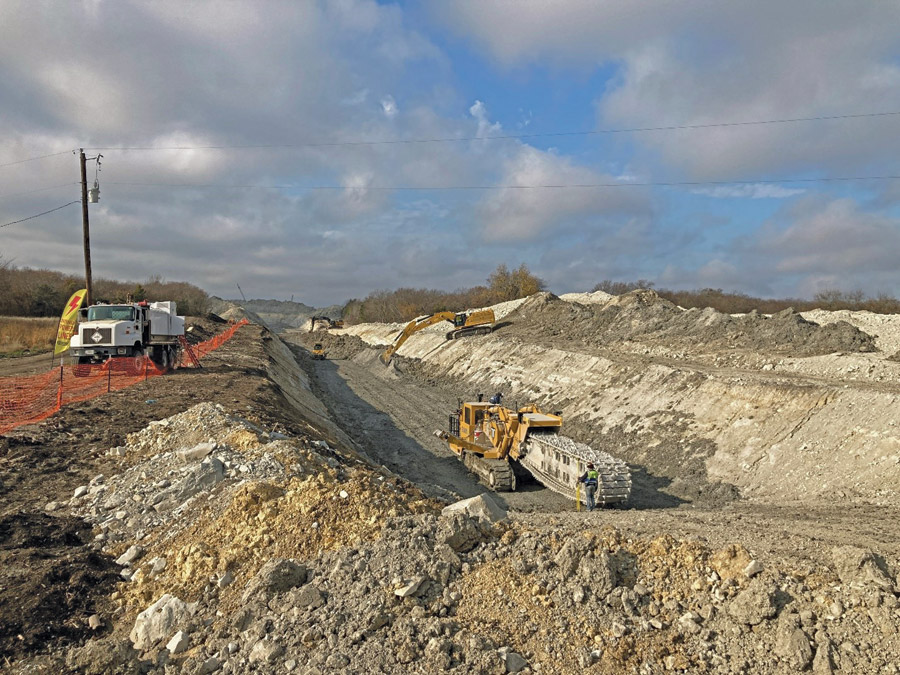
Crews were able to trencher about a 300-ft pass per day in the open-cut installation sections.
Photo Courtesy of Garney Construction
Built through an area that lies almost entirely on a rock formation just below grade, the pipeline construction team, led by construction manager at-risk Garney Construction, was tasked with delivering a gravity flow pipeline through tough terrain using a mix of open-cut installation and large diameter tunneling.
Adding to the contractor’s challenge, the project specified 20-ft-long, 96-in.-dia fiberglass pipe rather than conventional reinforced concrete pipe. Plus, crews had to excavate up to 60 ft deep to accommodate its gravity flow design.
“The nature of this project with the large diameter tunnels, incredibly deep excavations and the large diameter fiberglass pipe that’s gravity flow is technically very challenging,” says Andy Hawthorne, senior project manager at Garney. “On most pipeline projects with tons of footage of pipe, the challenge there is how do you make sure you stay on schedule and you’re keeping the crews moving. This one requires much more of a methodical approach. Technically, this is the most challenging project that I’ve built.”
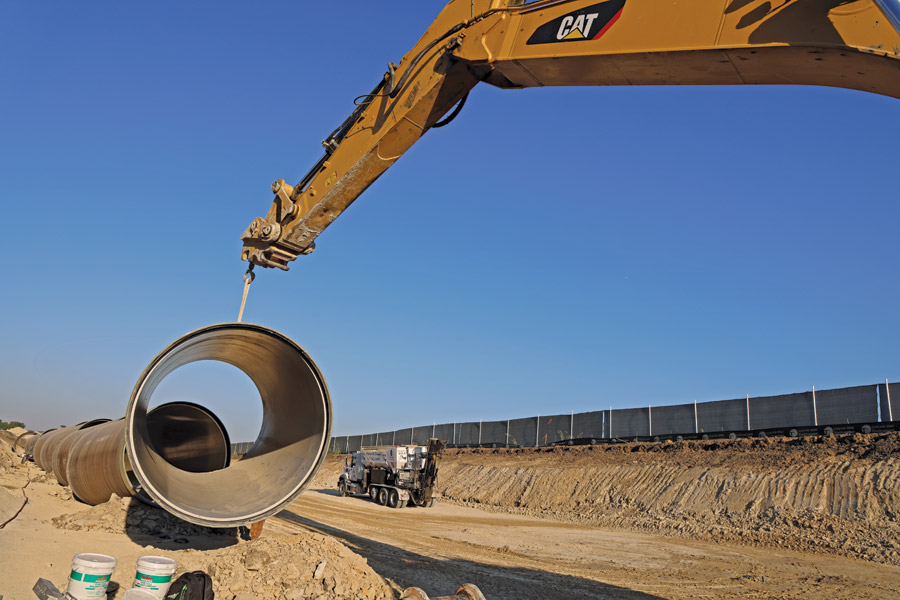
The team also specified use of fiberglass pipe versus conventional reinforced concrete pipe to help speed delivery.
Photo Courtesy of Garney Construction
CMAR Saves The Day
Hawthorne credits North Texas Regional Water District’s choice of a construction manager at-risk delivery method for making the undertaking possible. He says Garney was able to offer some guidance prior to 30% design, working with engineer CDM Smith early in the process to develop detailed cost estimates and schedules. Garney was able to make significant changes to construction methods, ultimately suggesting a combination of open-cut installation and tunneling. Although open cut seemed the most affordable option, tunneling proved to be the best solution in specific sections of the route that required deep excavation. The trenchless tunneling solution also significantly reduced the amount of easement needed and minimized disturbances to landowners.
“Technically, this is the most challenging project that I’ve built.”
—Andy Hawthorne, Garney Construction
The project’s scope ultimately included a total of 9,453 linear ft of large diameter tunneling with a 123-in. tunnel-boring machine and 12,071 linear ft of open-cut installation within mass excavations and vertical shoring.
Bret Ellis, engineering manager at North Texas Regional Water District, says CMAR was also valuable in helping the team decide what pipe should be used. “The biggest thing during design was being able to work with Garney to price out the cost of using two parallel 78-inch [diameter] pipelines or a single 96-inch [diameter] one,” he says. “We were also able to evaluate the impacts of coming back out and installing future pipelines in this corridor though future phases. That was a big savings.”
The Garney team also suggested including two 1,200-ft radius bends in the tunnel. The back-to-back bends were designed to reduce the number of tunnel shafts and access structures needed in the system. By adding it during the preconstruction phase, Garney estimates that the change resulted in roughly $1.1 million in savings per shaft for a total of $2.2 million.
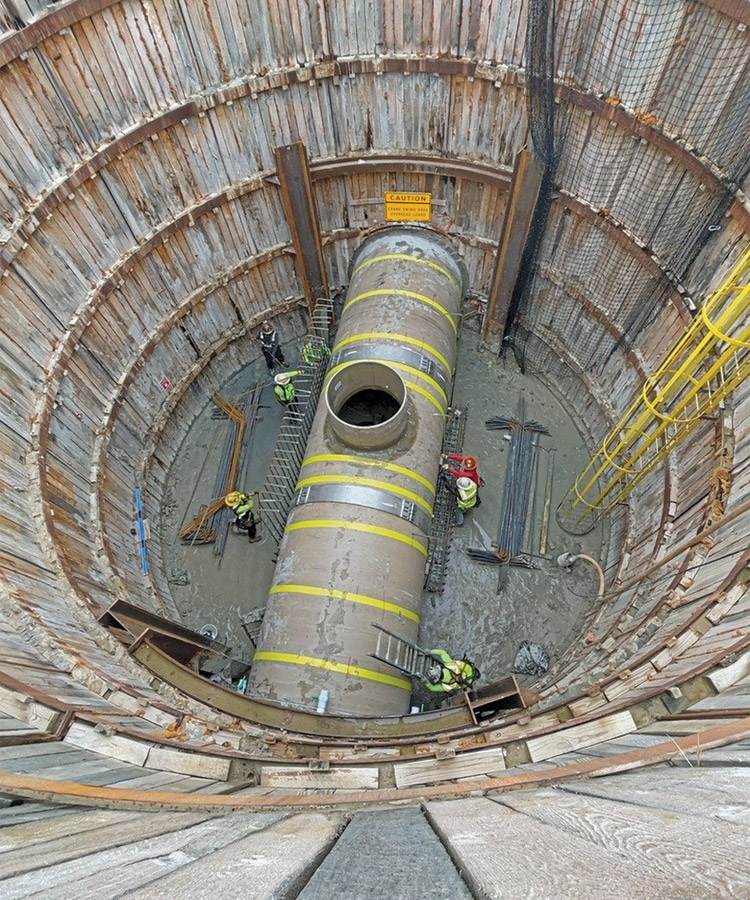
The project’s scope included a total of 9,453 linear ft of large diameter tunneling through the pipe corridor’s deepest sections.
Photo Courtesy of Garney Construction
The team also specified use of fiberglass pipe versus conventional reinforced concrete pipe. Hawthorne says that although fiberglass pipe is more expensive, the ease and speed of delivery made it a competitive option. “Reinforced concrete pipe is significantly heavier with much shorter joints, so it takes a lot more of them to get the same footage” he says. “The fiberglass pipe is 20 feet long versus an 8 feet long piece of RCP, so fiberglass proved cheaper for installation.”
Garney was also able to suggest where flowable fill specified in the original design could be substituted with crushed aggregate in areas of solid rock excavation. Garney estimates that the change equated to $2.1 million in budget savings. “We knew the aggregate would lock in between the sides of the excavation and the pipe and create a really stable foundation,” Hawthorne says. “Fiberglass pipe is flexible, so if you don’t have very good support all the way around the pipe, it will deflect.”
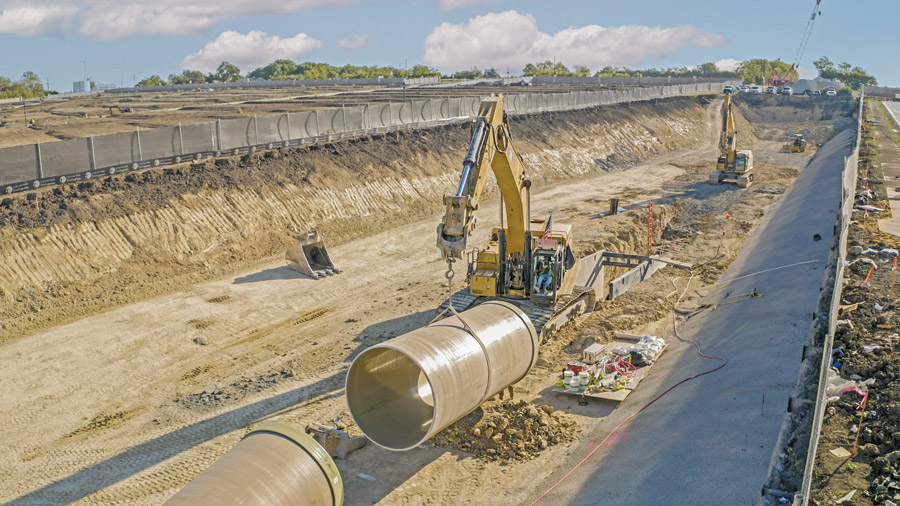
In lieu of tunneling through residential areas, the team devised a way to use shoring to reduce the footprint of the easement and lessening the impact of the installations.
Photo Courtesy of Garney Construction
Working Ahead
CMAR also proved critical for developing early work packages and focusing on long-lead items. While Garney’s contract was executed in January 2020, crews mobilized on site in April 2021, as supply chain issues were hitting the construction industry. There was also market uncertainty about raw materials needed for pipe manufacturing. Through early procurement, the team was able to secure pricing while allowing the vendor to ensure availability.
Early involvement also helped keep tunneling on track. “We faced a tremendous amount of challenges on material pricing and even securing the materials,” says Cliff Kassouf, president of Triad Engineering, which was part of a tunneling joint venture with C&M McNally and Midwest Mole.
“Our planning projections show that our recent expansions will reach 100% capacity in the next couple of years.”
—Bret Ellis, North Texas Regional Water District
Additionally, the tunnel-boring machine had to be shipped from China. “That’s when West Coast ports were overloaded and ships were sitting at sea,” he recalls. “There were some delays, but we made [lost time] up once we got going.”
The corridor passes through areas that are mostly uninhabited or sparse, but elevations varied slightly, so the gravity flow design passed through two areas that required excavations up to 60 ft deep. Garney’s plan called for tunneling in those two areas—one approximately 8,200 ft long, the other about 1,200 ft long—and open-cut installation in the three other sections. Garney’s crews self-performed the open-cut installations while the tunneling crews completed their scope.
Kassouf says that although it took some time to get the tunnel-boring machine tuned and ready to go, once tunneling started, the machine was able to cut through the soft limestone very quickly. Tunnel crews averaged 140 linear ft per day, using two-shift mining. “We ended up going probably three to four months quicker than we thought we would,” he adds.
To keep the machine running, a series of trains ran behind it with switches designed so that trains could pass each other efficiently.
The same TBM was used for both tunnel sections. Since the geology was essentially the same, Kassouf says the team was able to move the TBM from the first location to the second and get it up and running in about two weeks.
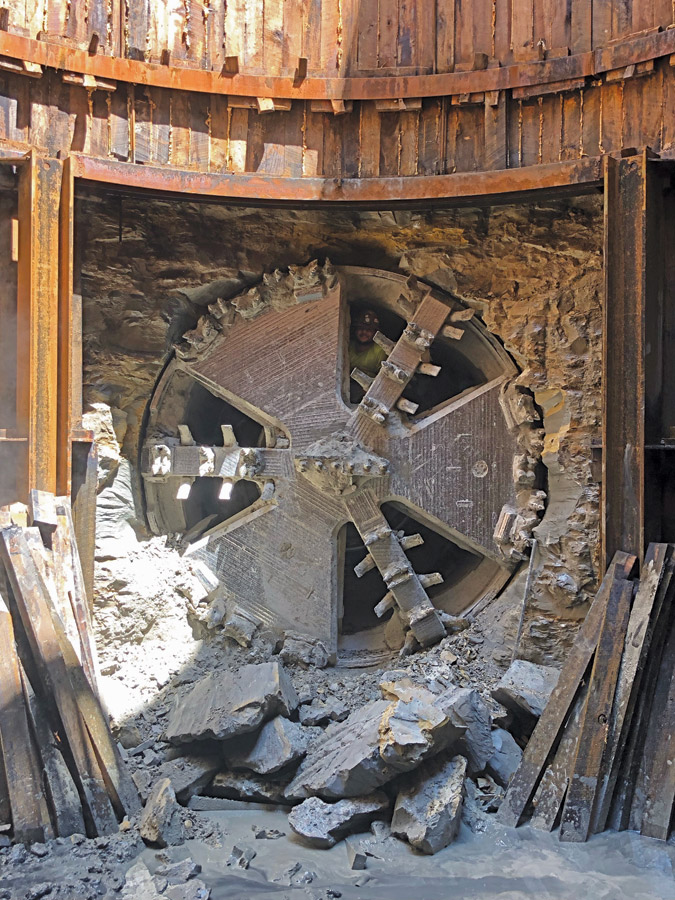
Tunnel crews averaged 140 linear ft of progress per day, using two-shift mining.
Photo Courtesy of Garney Construction
Brute Force
Hawthorne says that while the tunnel was a “finesse” operation, the open-cut sections were mostly “brute force” efforts. Similar to the tunneling, the softness of the rock allowed crews to move quickly. “We were able to come out with the largest dozers Komatsu makes and some Caterpillar D-10s and go to town ripping that rock,” he says. “The trencher we had was able to do about a 300-ft pass per day. That same size trencher could only do 25 ft per day on some other [Texas] jobs.”
In residential areas, however, Hawthorne says the open-cut work required more finesse and additional safety measures. Initially, the team considered extending the tunnels through residential areas. However, the team devised a way to use shoring to reduce the footprint of the easement and lessen the impact of the installation. Garney used steel beam, shotcrete and soil nail vertical shoring in these sections.
With the pipeline on track to complete in April, crews are making the final tie-ins and restoring open-cut areas.
Upon completion, the outfall pipeline will be ready to tie into the new Sister Grove Water Resource Recovery Facility, which is being constructed by another division of Garney. The plant is scheduled to be fully operational by mid-2024.
Ellis says the effort by Garney’s pipeline team is reflective of the collaborative and detailed planning used across the entire program. The new facility will be the first on the 1,000-acre site, and Ellis says the entire facility has been master-planned to guide future phases of growth. He says that being prepared to meet the infrastructure needs of local residents will be critical in the coming years as the area continues to develop rapidly.
“We have some of the fastest-growing communities in the country right now,” he says. “Our planning projections show that even our recent expansions will reach 100% capacity in the next couple of years. We need to be ready for it.”


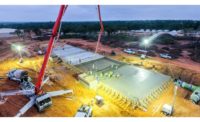
Post a comment to this article
Report Abusive Comment